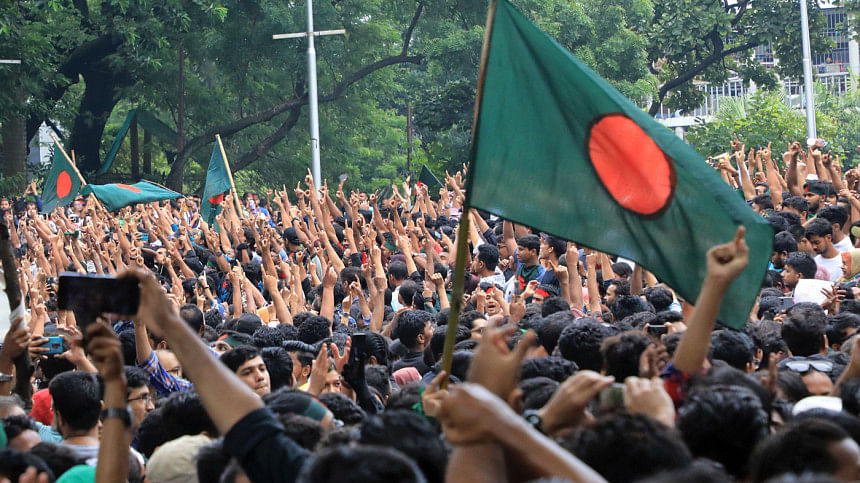July’s legacy and the myth of a singular vanguard

In the aftermath of Sheikh Hasina's long and repressive rule, Bangladesh stands at a critical juncture. A moment of rupture—so rare in the history of managed autocracy—has passed into the hands of an interim government. But the narratives now emerging to explain this rupture have taken a troubling turn, shaped less by truth and more by convenience, exclusion, and political opportunism.
The July-August movement, which culminated in the collapse of Hasina's regime, is now increasingly portrayed as the work of a select few—a tightly curated band of young leaders, most of whom are now prominently placed within the interim administration or in the leadership of the National Citizen Party (NCP). This narrative is seductive in its clarity but wholly inadequate in truth. It erases the broader architecture of revolt and misrepresents the diffuse forces that brought a despotic government to its knees.
To begin with, the origins of the July uprising have been widely misunderstood, both by foreign observers and Dhaka's own elite commentariat. The protests began not with any grand vision, but with a specific demand: the reform of quotas in public sector employment, a cause resurrected by students and graduates of public universities. Similar protests had occurred before and had been quelled with surgical repression and partial concessions. There was every reason to believe that this cycle would repeat.
However, in mid-2024, something shifted. The Hasina government, perhaps influenced by sensitive geopolitical considerations, particularly widespread rumours of a controversial agreement with a neighbouring country regarding regional transit access, chose not to act swiftly. Many suspected the regime was deliberately allowing unrest to simmer to distract public attention from the brewing scandal. This initial hesitation gave the protests time to gain momentum. When repression did follow, it was late—and though brutal, it failed to extinguish the surging dissent.
The original organisers, many of whom would later rise to visibility under the NCP banner, were eventually silenced or sidelined. But by then, the fire had spread. Two unexpected sources breathed new life into the movement. The first, students from private universities and madrasas, who had long been absent from traditional protest politics but now poured into the streets. The second, the disillusioned youth who had borne the brunt of state violence in the earlier quota and road safety movements of 2018. These young people, with no formal structure, no single leadership, and no declared ideology, refused to bow again.
When the state murdered Abu Sayeed, and the video of that killing went viral, the dam burst. What had been a series of localised protests transformed into a national uprising. The movement had no high command, no manifesto, no designated leaders. It was organic, collective, and entirely uncontainable.
Yet today, we are told that it was engineered and executed by a narrow circle of now-prominent faces. This fiction has taken root in part because of the failure of Dhaka's elites to understand how political movements actually operate. The city's educated class, largely distant from the barricades and relying on a media ecosystem long dominated by the Awami League's propaganda machine, saw only what they were permitted to see. They mistook visibility for authorship. Worse, they swallowed, almost uncritically, the regime's 15-plus years of campaign to delegitimise the BNP and all other organised opposition as corrupt or obsolete. Thus, when the government fell, the vacuum of credible opposition in their minds was filled by those closest to the microphones.
This misunderstanding was further compounded by the rhetoric of the interim government, led by Prof Muhammad Yunus. In speech after speech, the administration invoked its gratitude to the "youth who overthrew Hasina." The implication was clear: the interim government derived its moral authority from a small group of young figures. The result was the mythologising of a few and the erasure of the many—students, activists, ordinary citizens, and political parties—who had fought and sacrificed just as much, if not more, for the cause.
This narrative, at first a convenient fiction, has now become a political liability. It is impeding the country's path back to democracy. The NCP, buoyed by its proximity to power and flattered by the narrative of singular heroism, has shown little interest in an early or competitive election. Whether out of inexperience, fear of electoral defeat, or a desire to prolong their influence, they appear unwilling to embrace the fundamental logic of democratic transition.
Their reluctance has begun to fracture the fragile post-Hasina consensus. Tensions have emerged between the NCP-led factions of the interim government and the country's armed forces, which have thus far acted with caution and restraint. Relations with the BNP, a party with deep organisational capacity and electoral legitimacy, are strained, and clashes with other democratic parties seem inevitable. Meanwhile, the business community, whose support is crucial for economic stability, has grown increasingly disillusioned by the lack of direction and support for commercial recovery.
This impasse cannot persist. We cannot be governed by myth. We must be governed by mandate. The only legitimate path forward is a fresh, free, and competitive general election, one that welcomes all parties, reflects the diversity of voices that took part in the uprising, and restores institutional balance. To reach that point, we must dismantle the false narrative that the NCP leaders alone were the architect of Hasina's fall. This version of events has bred arrogance, exclusion, and political gridlock. More dangerously, it risks repeating the very centralisation of power that the movement sought to dismantle.
The July mass uprising was not the triumph of a single party. It was a broad movement against tyranny. To reduce it to a footnote in someone else's story is not only dishonest, but a betrayal of the people who risked everything for a new beginning. The time for mythmaking is over. The time for elections has come.
Bobby Hajjaj is the chairman of Nationalist Democratic Movement (NDM) and a faculty member at North South University. He can be reached at [email protected].
Views expressed in this article are the author's own.
Follow The Daily Star Opinion on Facebook for the latest opinions, commentaries and analyses by experts and professionals. To contribute your article or letter to The Daily Star Opinion, see our guidelines for submission.

 For all latest news, follow The Daily Star's Google News channel.
For all latest news, follow The Daily Star's Google News channel. 








Comments